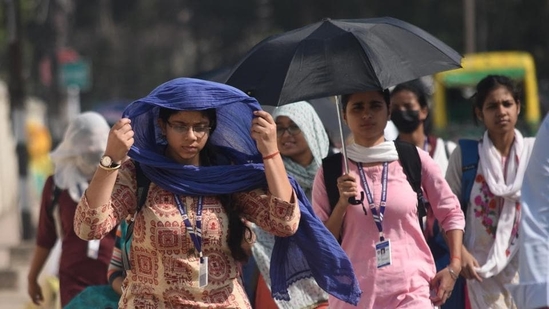India, a country known for its diverse landscapes and climate zones, is no stranger to extreme weather conditions. However, the frequency and intensity of scorching heat waves in recent years have raised concerns about how prepared the country is to face the challenges posed by rising temperatures. As the summer months approach, with the mercury expected to soar, it’s crucial to ask: Is India ready for the scorching heat?
1. The Rising Temperature Trend
Over the past few decades, India has experienced a steady rise in average temperatures, and the effects of global warming have become more apparent. According to the India Meteorological Department (IMD), the country has seen an increase in the frequency of heatwaves, particularly during the pre-monsoon and summer seasons.
Heatwaves are not just uncomfortable; they can also have serious health, economic, and environmental consequences. For instance, cities like Delhi, Jaipur, and Ahmedabad often experience temperatures exceeding 45°C (113°F) during peak summer months, with the urban heat island effect making the situation even worse. The 2015 heatwave that claimed thousands of lives was a tragic reminder of the devastating impact of extreme temperatures in India.
2. Impact on Health
One of the most pressing concerns regarding rising temperatures in India is the direct impact on public health. Heatstroke, dehydration, and heat exhaustion are common consequences of prolonged exposure to high temperatures. Vulnerable groups such as the elderly, children, outdoor workers, and people with pre-existing health conditions are at a higher risk of heat-related illnesses.
The World Health Organization (WHO) estimates that extreme heat will cause an increase in deaths related to heat stress, particularly in countries like India. Cities like Mumbai, Chennai, and Kolkata are expected to bear the brunt of this crisis as they are densely populated and prone to higher temperatures, combined with high humidity levels.
3. Infrastructure and Urban Planning Challenges
India’s infrastructure is often ill-equipped to handle prolonged periods of extreme heat. Many cities suffer from inadequate urban planning, lack of green spaces, poor ventilation, and inefficient cooling systems. The rapid urbanization and unplanned expansion of cities have resulted in the creation of urban heat islands, where the concentration of concrete, asphalt, and vehicles exacerbates the intensity of heat.
Air conditioning is not a viable solution for everyone, as electricity consumption spikes during the summer months, putting pressure on the already overstressed power grid. Additionally, many rural areas lack access to basic cooling infrastructure, which leaves communities vulnerable during heat waves.
4. Government Measures and Preparedness
The Indian government has started to recognize the importance of preparing for extreme heat. In recent years, the Ministry of Earth Sciences has issued early warnings about heatwaves to help the public and local authorities take preventive measures. The National Disaster Management Authority (NDMA) has also developed guidelines for managing heatwave risks and response strategies.
Several state governments, especially in regions like Maharashtra, Rajasthan, and Gujarat, have implemented heat action plans that include:
- Public awareness campaigns to educate people about the risks of heatwaves and how to protect themselves.
- Setting up cooling centers in vulnerable areas like hospitals, public buildings, and schools.
- Providing access to safe drinking water and encouraging hydration during the hottest months.
- Supporting outdoor workers by ensuring they are provided with cooling stations and water breaks.
While these efforts are commendable, there is still a need for more widespread implementation, especially in rural areas, where resources and awareness are limited.
5. Climate Resilience and Adaptation
As climate change accelerates, adapting to extreme heat becomes increasingly urgent. Experts argue that India needs to focus on long-term solutions to build climate resilience. One of the key approaches is urban greening, which includes increasing the number of parks, green roofs, and tree cover. These measures can help reduce the urban heat island effect, absorb carbon, and provide natural cooling.
Another solution is sustainable building practices, such as improving the insulation of homes, using reflective roofing materials, and adopting passive cooling techniques in construction. Government initiatives like the Smart Cities Mission and the Atal Mission for Rejuvenation and Urban Transformation (AMRUT) can play a significant role in improving urban resilience against extreme heat by incorporating green spaces and climate-smart infrastructure.
6. The Role of Technology and Innovation
Technology also offers potential solutions to mitigate the impact of extreme heat. Innovations such as solar-powered cooling systems, the use of water-mist technology in public spaces, and weather forecasting models can help predict and manage heat waves more effectively.
There is also growing interest in heat-resistant crops, which could help mitigate the impact of extreme temperatures on agriculture. As agriculture is a significant part of India’s economy, ensuring that crops can withstand rising temperatures will be vital for food security.
7. Public Awareness and Behavioral Change
The key to managing the challenges posed by scorching heat lies not only in government action but also in individual and community-level preparedness. Public awareness about the dangers of heatwaves, the importance of hydration, and the need for protection from the sun must be widespread.
Education on heat-related risks should be integrated into school curriculums, local government programs, and workplace health guidelines. Encouraging behavior changes, such as staying indoors during peak heat hours and using protective clothing, can help reduce the risk of heat-related illnesses.
8. Conclusion: Is India Ready?
India is making strides toward addressing the challenges posed by scorching heat, but it still has a long way to go. The rise in temperatures due to climate change presents an ongoing challenge that will require comprehensive action across all levels—government, infrastructure, technology, and public awareness.
While there have been efforts to improve heat action plans and mitigate the effects of extreme heat, the country must continue to prioritize climate adaptation, urban planning, and innovative solutions to better prepare for the scorching heat that lies ahead. By investing in long-term strategies and creating a collective commitment to tackling this problem, India can become more resilient to extreme heat and safeguard its citizens from the dangers posed by a warming planet.
In short, while progress has been made, India’s readiness for scorching heat remains a work in progress, and the need for stronger, coordinated action has never been more urgent.




